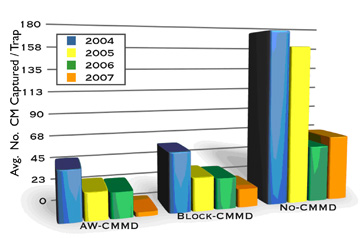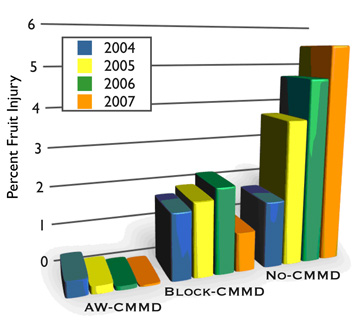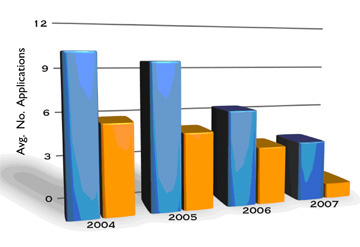Michigan growers successfully manage codling moth with areawide mating disruption
Editor’s note: This article is from the archives of the MSU Crop Advisory Team Alerts. Check the label of any pesticide referenced to ensure your use is included.
Starting in 2004, Michigan apple growers have been successfully implementing whole-farm, or areawide, codling moth management that uses pheromone-based mating disruption as the centerpiece of their control programs. This novel technology controls codling moth by interfering with the normal mating process and thus curtailing the production of offspring.
Although codling moth mating disruption has been practiced in apple orchards around the world for nearly two decades, many practical and economical concerns with the approach have slowed its widespread adoption. In apple growing regions like Michigan, challenges of incorporating pheromone disruption into pest management programs include costs for managing a multitude of insect and disease pests, availability of labor for hanging pheromone dispensers, and a farmland topography in which orchards are interspersed with other crop or non-crop habitats. Indeed Michigan orchards are often surrounded by woodlots and neglected blocks that support populations of pest insects. The Codling Moth Areawide Mating Disruption Project has entailed working with Michigan apple growers in directly addressing these challenges, and results show that mating disruption is both effective and economical under Michigan conditions.
For participating apple growers, the economic and social value of the development and delivery of this viable approach to managing codling moth was quite timely. Prior to the start of this project, growers had experienced increasing difficulty in controlling codling moth, in part due to the development of codling moth resistance to the most relied upon insecticide, azinphosmethyl. Especially high levels of azinphosmethyl resistance had developed in the Fruit Ridge region north of Grand Rapids, Michigan. Ridge growers had over 10 truckloads of fruit rejected in 2003. Statewide, more than 300 worms were detected in truckloads of apples delivered to packers and processors. It was in this climate that this project began, and one of the notable results of the Michigan areawide codling moth management project is that there have been no rejected loads of fruit associated with any participating farm since its start in 2004.
Mating disruption is a welcome addition to the apple IPM toolbox because it completes the spectrum of tactics needed to target every stage of the codling moth’s life cycle. Organophosphorous insecticides, used for more than 50 years, were lethal to every life stage of this insect. The recent development of resistance to azinphosmethly has reduced this chemical's effectiveness for codling moth control on many farms. Newly registered insecticides act on either the egg or larval stages of development, but few have the ability to knock down adults, thus leaving a hole in the pest management program. A single mated female codling moth can lay over 100 eggs putting enormous pressure on these new insecticides to provide control. Pheromones help to reduce the reproductive capacity of the population and further reduce pest pressure while remaining safe to beneficial insects in the orchard.
Our project marked the first time that the efficacy of mating disruption deployed in an areawide fashion (AW-CMMD) was measured against mating disruption deployed in individual farm plots (Block-CMMD) and insecticide only programs (No-CMMD) on adjacent farms. The reasoning behind adopting an areawide strategy is that it will improve the overall performance of mating disruption. Taking this approach mitigates the likelihood of mated females flying in from adjacent plots and depositing their eggs within disrupted orchards, especially along the border. We also have noted that disruption works best when used in the same orchard for several consecutive years. As moth populations are lowered over time, fewer insecticide applications targeting codling moth control are required.
Starting with eight growers on 800 acres in 2004 in Kent and Ottawa counties, the Michigan areawide project expanded in four years to approximately 3,000 acres on over 30 farms throughout Berrien, Cass, Monroe and Grand Traverse counties. The project not only demonstrated the superior effectiveness of areawide mating disruption, but also served as a catalyst to promote the adoption of mating disruption in the wider Michigan apple industry. Over 8,000 acres of Michigan apple were treated with mating disruption in 2007, up from ca. 4,000 treated acres prior to the start of the project.
Participants in the areawide project realized greatly improved control of codling moths as documented by substantially reduced captures of male moths in pheromone baited traps, improved protection of fruit from injury, and reduced use of insecticides targeting codling moth control. Captures of male codling moths in pheromone-baited traps were reduced 93 percent in blocks in Kent and Ottawa counties deploying AW-CMMD pheromone disruption for the full four years of the project. In the first year alone, AW-CMMD codling moth captures were reduced by 81 percent. Orchards using the Block-CMMD saw only a 48 percent reduction and orchards not utilizing pheromones saw catch increase by 20 percent. This reduction in moth catches was a reflection of the growers’ success in reducing codling moth populations and enabled growers to reduce the overall number of companion insecticide applications from 10.1 to 5.2. The average application of organophosphorous insecticides targeting codling moth dropped from 5.8 pounds in year one to ca. 2.2 pounds in 2007, a 65 percent reduction.

Figure 1. Average moth captures in plots treated with areawide
mating disruption (AW-CMMD), block mating disruption
(BLOCK-CMMD), or insecticides only (NO-CMMD) over the
course of the four-year Michigan areawide project.
* Dates read from left, 2004 to right 2007.
The overall trend of superior results in areawide blocks held true for fruit protection as well. Fruit injury decreased in the AW-CMMD orchards over four years, while it increased in the other programs. Fruit injury attributed to codling moth was 95 percent lower in AW-CMMD blocks than in No-CMMD blocks relying on insecticide, alone. Furthermore, fruit injury was 30 percent lower in AW-CMMD blocks as compared to Block-CMMD on nearby farms outside of the project. Fruit injury was highest where pheromone was not used. Fruit injury from codling moth was 0.7 percent in the AW-CMMD in 2007, and 5.5 percent in neighboring No-CMMD farms outside the project. Overall, these findings reveal that mating disruption is most robust when used on an areawide basis, but that treating individual blocks with pheromone is better than relying on insecticides only for codling moth control. This past year, Fruit Ridge growers stuck with the AW-CMMD approach and continued to see excellent fruit protection despite sharply reducing insecticide use. Some growers completely removed all sprays targeting codling moth, after suffering severe hail damage in early summer, and still did not see infestations develop.

Figure 2. Percent fruit injury in plots treated with areawide mating
disruption (AW-CMMD), block mating disruption (BLOCK-CMMD),
or insecticides only (NO-CMMD) over the course of the four-year
Michigan areawide project.
* Dates read from left, 2004 to right 2007.
A key contributor to the success or failure of mating disruption programs is the program for monitoring pest populations. Inadequate monitoring can result in undetected codling moth populations exceeding treatment thresholds and ultimately crop loss at harvest due to infested fruit. As orchard production systems move toward greater reliance on pheromones and narrow-spectrum and relatively expensive insecticides, more precise trapping systems are required to monitor codling moth activity and aid in making cost-effective management decisions. In the absence of reliable information, growers generally error on the conservative side and cover with several insecticide sprays. This scenario certainly hinders a grower's ability to produce apples profitably and contributes to the development of insecticide resistance. All orchards in this program were monitored using large delta-style traps baited with two types of lures; either codling moth 1x or high load codling moth 10x lures. The codling moth 1x lures indicate how well the mating disruption treatment is inhibiting males from finding females while the high load lures enable the grower to monitor the overall population of codling moth remaining in the orchard. Traps were deployed at one per 2.5-3 acres and monitored each week. Using high trapping densities allowed us to more accurately measure the distribution of codling moth throughout the orchard. Consequently, growers had the information they needed to reduce cover sprays by selectively applying insecticides only where moth catches indicated they were warranted. The added cost associated with trap supplies and scouting is easily offset by the elimination of only a single insecticide application.
The Michigan areawide project has had a major impact in advancing the adoption of mating disruption by apple producers in the state of Michigan. Growers have learned that it works well and is cost-effective. The cost of mating disruption deployment and biological monitoring ranged from $125-$170 per acre, depending on the number of dispensers per acre and type of dispenser chosen. The additional returns for reduced insecticide use and increased pack-out of non-damaged fruit on farms using AW-CMMD for four years ranged from $210-$305 per acre per year. Thus, net returns greatly exceeded net costs for the 20 farms studied in this analysis, demonstrating that AW-CMMD is a very cost efficient management approach. Most of the apple growers continue to use AW-CMMD despite the registration of several new and effective insecticides. Combining both pheromones and a few well-timed sprays using these compounds is effective and economical and has proven to maintain codling moth populations at low levels year after year. Outbreaks of codling moth are one unwelcome surprise growers don’t miss.



 Print
Print Email
Email



